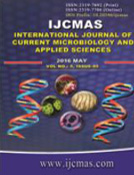


 National Academy of Agricultural Sciences (NAAS)
National Academy of Agricultural Sciences (NAAS)

|
PRINT ISSN : 2319-7692
Online ISSN : 2319-7706 Issues : 12 per year Publisher : Excellent Publishers Email : editorijcmas@gmail.com / submit@ijcmas.com Editor-in-chief: Dr.M.Prakash Index Copernicus ICV 2018: 95.39 NAAS RATING 2020: 5.38 |
The effects of plant leaves and supplemental plant leaves on the growth and nutrient utilization of African giant land snail Archachatina marginata were investigated for 168 days. Forty African giant land snail juveniles (10.0±4.9g) were obtained from the University Teaching and Research Farm and stocked five snails per wooden cage of dimensions 1m x 0.6m 0.45m filled with 15cm soil thickness. The wooden cages were raised 10cm above the ground with four wooden legs and the African giant land snail was fed at 2% body weight per day of its specific diet treatment. The diet treatments were fresh green pawpaw leaves, fresh green pawpaw leaves plus 25% crude protein diet, fresh green sweet potato leaves, and fresh green sweet potato leaves plus 25% crude protein diet designated diet treatments (I – IV) respectively. Mortality of 30% was recorded on diet treatment III and no mortality was recorded in the other diet treatments. The mean body weight gain of the African giant land snail in diet treatment II (fresh green pawpaw leaves plus 25% crude protein diet) was significantly influenced (p<0.05) more than the mean body weight gain of the African giant land snail in the other diet treatments (I, III, IV). No significant difference (p>0.05) existed among the mean body weight gain of the African giant land snail fed in diet treatments I (fresh green pawpaw leaves) and IV (fresh green sweet potato leaves plus 25% crude protein diet) that differ significantly (p<0.05) from the mean body weight gain of the African giant land snail in diet treatment III. Morphological parameters (shell length, shell width) each of the study animal in the diet treatment did not differ significantly (p>0.05) at the end of the study period. Diet treatments II and IV gave the lowest feed conversion ratio (FCR) of 1.8 each and diet treatment III gave the highest FCR of 3.0. The diet treatments followed the reversed trend in the protein efficiency ratio (PER).
 |
 |
 |
 |
 |